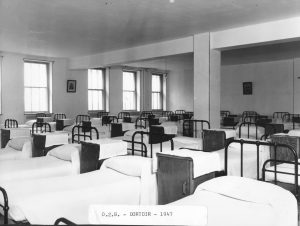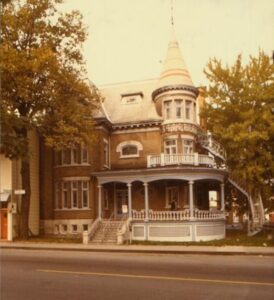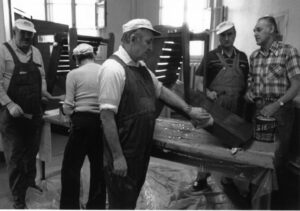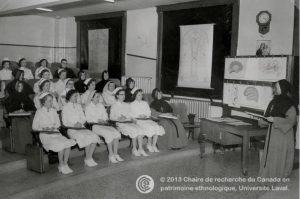Hôpital Saint-Michel-Archangel
Name(s) of Institution:
Hôpital Saint-Michel-Archange
Asile provisoire de Beauport (founded 1845)
Quebec Lunatic Asylum (renamed 1850)
Asile des aliénés de Québec (renamed 1865)
Asile Saint-Michel-Archange (renamed 1912)
Hôpital Saint-Michel-Archange (renamed 1914)
Centre hospitalier Robert-Giffard (renamed 1976)
Institut universitaire en santé mentale de Québec (renamed 2009)
Opened:
1845
Location:
Beauport (now annexed to Quebec City)
Period of Deinstitutionalization:
1960-1980
Patient Demographic:
| YEAR | TOTAL | STAFF | YEAR | TOTAL | STAFF |
| 1845 | 23 | 1925 | 1624 | ||
| 1850 | 275 beds | 1935 | 2576 | ||
| 1893 | 958 | 1945 | 3701 | ||
| 1909 | 1480 | 3 doctors | 1952 | 4500 | 1300 staff |
| 1918 | 1453 | 1961 | 5127* |
* 15% diagnosed as “mentally retarded”
Deinstitutionalization:
In 1962, the report produced by the Study Commission of Psychiatric Hospitals, better known as the Bédard Commission, triggered deinstitutionalization in Quebec’s psychiatric hospitals. The commission proposed a major modernization of the province’s psychiatric system, still largely dominated, as Bédard noted, by a traditional treatment based on “prayer, good words, promises of reward, physical restraint, firmness, threats, punishments, and sanctions.” The Castonguay–Nepveu Commission in 1967, eventually resulted in the adoption of the Protection of the Mentally Ill Act in 1972. The following year saw the Bélanger Report, which emphasised the need for structural reforms originally proposed by the Bédard Commission. Psychiatric services across the province experienced significant expansion, regionalization, and diversification.

The deinstitutionalization process was a complex one in the larger hospitals such as Saint-Michel-Archange and Saint-Jean-de-Dieu. Certainly, the internal population of Saint-Michel-Archange hospital declined during the first decade of deinstitutionalization, from 5,127 residents in 1962 to 3,219 in 1970. The number of annual admissions fell from 1,481 to 571 during the same period.
A professional social service department, under the direction of nurse and social worker Edda Leczinska, was created in Saint-Michel-Archange in 1963.
In 1969, a drug rehabilitation service was inaugurated and admitted 160 people.
A reception center and an outpatient resources service were also created to ensure psychiatric patients access to therapeutic and support services outside the hospital.
In 1970, of the 1,675 patients who were released from Saint-Michel-Archange, 889 (53 percent) were returned to their families, 48 (2.3 percent) lived in residences in the community, and 71 (4.2 percent) were moved to other institutions.

Transinstitutionalization:
By 1966, there were twenty-nine community residences affiliated with the institution. In 1974, they numbered thirty-nine and hosted a total of 237 patients. There were also ninety-five monitored boarding homes that housed 271 people. However, this community housing was too limited to meet institutional needs.
Outpatient clinics affiliated with the Saint-Michel-Archange Hospital included The 388, a psychoanalytic treatment center for people with psychosis.
Work Therapy into Occupational Therapy:

In 1922, 430 patients at Saint-Michel-Archange worked from morning to night in various jobs. In the early 1960s, this was still the case, with 2,480 hospital patients assigned to cooking, housekeeping, and laundry. The Bédard Commission report argued that “this form of activity that must be differentiated from occupational therapy has not, in our opinion, the therapeutic value it should have. It is principally officers of the department who makes the choice for patients and they are more concerned about efficiency than therapeutic need.”

During the 1960s, the hospital set up different activities for the purpose of occupational therapy (ergotherapy, industrial therapy, recreation therapy). A team of twenty-six female graduates in Family Studies organized workshops for patients in sewing, knitting, embroidery, painting, making trinkets, and cooking. In the men’s section, workshops were offered in wood carving, ceramics, leather and tin embossing, painting in oil, weaving, rug hooking, and necklace confection. Sporting events were organized, including an annual hospital Olympics. Singing and music classes were also added as the decade progressed.
Patient Into Person:
From 1965, patients also participated in the drafting and editing of a newspaper called La Brèche (The Breach).
Staffing in the Deinstitutionalization Era:

In 1956, the hospital had 1,147 staff members, including 210 nuns, 50 medical specialists and grade 5 medicine students, 49 psychiatric nurses, 51 graduate nurses, 63 nursing students, 30 regular nurses, and one religious male nurse who attended the courses in Psychiatry. In addition, there were 486 attendants, 5 chaplains, about 10 technicians, 2 psychologists, 1 photographer, 13 clerks, 1 engineer, and a number of members of various trades.
Increased professionalism was an aspect of the deinstitutionalization project at Saint-Michel-Archange. The Bédard Report had stated that the number of psychiatrists should be quadrupled, the lone psychologist should be multiplied by five, the social workers by ten, the number of nurses by four, and an additional twenty occupational therapists and thousand hospital attendants should be hired.
By 1965, twelve psychologists were working in the hospital. In the following years, the Saint-Michel-Archange Department of Psychology began to accept internships and residencies for psychology students from Laval, Ottawa, and Moncton Universities.
The nursing staff also continued to increase in numbers during the 1960s. At the end of 1965, there were 269 graduate nurses. The following year, the number reached 294, plus 77 nursing assistants. In 1967, the hospital had 1,718 people assigned to nursing.
Sources:
Bédard, Dominique, et al. Rapport de la Commission d’études des hôpitaux psychiatriques. Quebec City: Health Minister, 1962.
https://www.msss.gouv.qc.ca/sujets/prob_sante/sante_mentale/download.php?f=f8571bc8ed9d19dc9a35c6bcdc18d293.
Boudreau, Françoise. De l’asile à la santé mentale : les soins psychiatriques : histoire et institutions. 2e édition. Montréal: Éditions Saint-Martin, [1984] 2003.
Fleury, Marie-Josée, et Guy Grenier. «Historique et enjeux du système de santé mentale québécois.» Ruptures, revue transdisciplinaire en santé vol. 10, n° 1 (2004): 21–38.
Lambert, Jules. Mille fenêtres. Beauport: Centre hospitalier Robert-Giffard, 1995.
Lecomte, Yves. «De la dynamique des politiques de désinstitutionnalisation au Québec.» Santé mentale au Québec vol. 22, n° 2 (1997): 7–24.
L’Institut universitaire en santé mentale de Québec (IUSMQ). « Histoire » L’Institut universitaire en santé mentale de Québec (IUSMQ). https://www.institutsmq.qc.ca/a-propos-de/histoire/index.html#c623
Wallot, Hubert. La danse du fou entre la compassion et l’oubli : Survol de l’histoire organisationnelle de la prise en charge de la folie au Québec depuis les origines jusqu’à nos jours. Beauport: Beauport Publications MNH, 1998.


